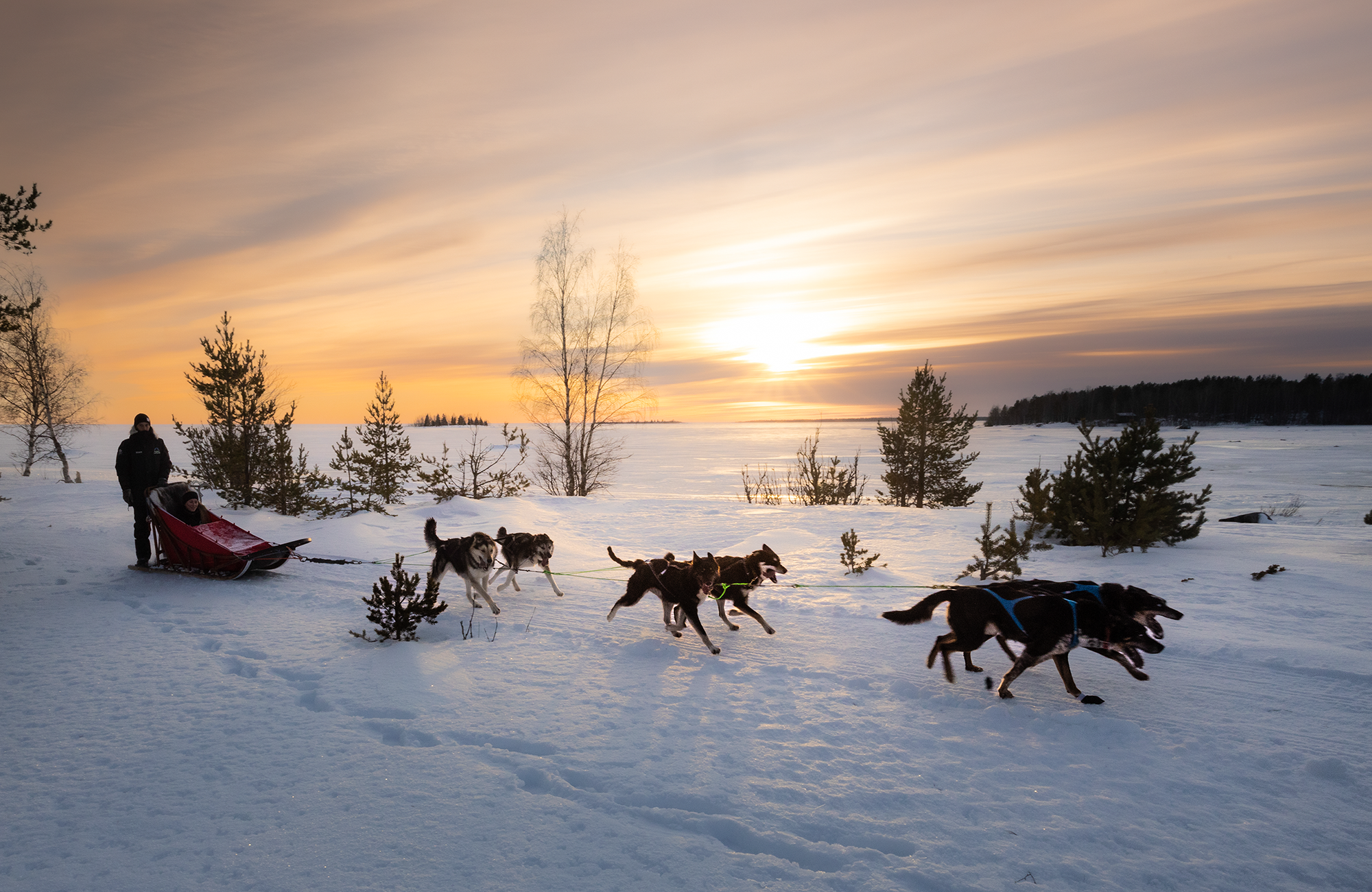I recently traveled to Swedish Lapland, where I discovered the challenges of capturing stunning photographs in extremely cold weather conditions. Winter is here, and with it comes the need to be prepared for the elements to ensure the safety of yourself and your equipment. In this blog, I'll share 7 tips on how to prepare yourself as a photographer for a successful winter photography session!
Tip 1: Protect your camera!
When shooting in cold weather, it's crucial to protect your camera so it keeps working and producing stunning photos. A waterproof lens and body (with a rating of at least IPX4) will keep the snow and rain at bay. Also, be mindful of lens condensation when taking your camera from the cold outside to a warm room. Prevent it by using a lens hood or waiting until it adjusts to the temperature before removing it from its bag. To keep your camera warm, stash it in a camera bag or coat pocket and add an extra layer of protection with a waterproof cover or protective case.
Additionally, it's important to pay attention to your tripod. Opt for one with leg locks that are easy to operate with gloves on and made from materials that won't become brittle in low temperatures, like carbon fiber. Some tripods also feature spiked feet for better stability on icy surfaces.
Tip 2: Bring extra batteries!
It is essential to have extra batteries on hand. Cold temperatures can quickly drain batteries, making it important to have backups in case your primary battery runs out of power.
To preserve the best performance, it is important to keep your spare batteries warm. Keeping spare batteries in the inside pocket of your jacket or camera bag will help to maintain their charge and ensure they are ready to use when needed. When you are not using your camera, it's best to remove the battery and keep it inside your pocket or in a warm place. This will prevent the battery from discharging too quickly due to cold temperatures.
When you are using your camera in cold weather, it's important to be mindful of battery usage. Try to limit the use of battery-draining features such as the LCD screen and image stabilization. Instead, use the viewfinder to compose your shots and try to take your pictures in natural light as much as possible. Additionally, you can use heat pads to keep your batteries warm, I explained more about them in TIP 6.
Tip 3: Keep your phone warm!
Just like a camera, cold temperatures can also impact your phone's battery life. To preserve its battery, keep your phone warm by keeping it in a warm pocket or insulated bag when not in use. When taking photos in the cold, minimize battery drain by avoiding using the LCD screen, flash, and heavy apps too much. Instead, try to utilize natural light for your shots. Also, keep your phone and battery warm when charging by avoiding charging it in extremely cold environments and instead charging it in a warm room or using heat pads.
Tip 4: Keeping warm yourself!
When it's cold out and you're taking photos, keeping warm is a must. Investing in a quality jacket is key to staying comfortable. Layering your clothing is an important way to adjust to temperature changes - a base layer of thermal or moisture-wicking material will keep you dry and warm, a mid-layer like a fleece or wool sweater provides extra warmth, and a top layer like a jacket shields you from wind and snow. A puffy jacket is great for photographers as it gives great insulation while allowing for movement.
Make sure the jacket is comfortable and flexible, not too stiff. If possible, try to find one with water-repellent treatment - this will help keep you dry during rain or snow. Unpredictable weather can always be an issue, so make sure you keep a waterproof jacket in your camera bag. That way, you'll be prepared for any surprise precipitation that comes your way.
Tip 5: Gloves for photographers!
Having the right gloves while taking pictures in cold weather conditions is crucial. I have found LINER gloves from The Heat Company, which are designed specifically for photographers, and for me, they are the best option as they provide a balance of warmth, durability, and dexterity.
The key to staying warm when taking pictures in the cold is layering. The gloves I use have a three-layer design, with a durable and water-resistant outer layer, an insulating middle layer, and a soft inner layer that wicks away moisture. This combination keeps my hands dry and warm even in the most extreme temperatures. Additionally, these gloves are made from very warm and soft Merino Power Wool™, which is highly breathable, keeping your skin dry and naturally anti-odour.
1st layer: The LINER INNER GLOVES with the heat pad pocket on top
One of my favourite features of these gloves is the ability to add heat pads. These heat pads can be inserted into a pocket in the gloves and provide extra warmth on particularly cold days. It's like having a personal heater for your hands! The gloves also include an extra pocket specifically for HEAT Handwarmers, enhancing their warming capability.
The gloves also have a flexible design that allows for a full range of motion, which is important for a photographer who needs to operate their camera and adjust settings.
The gloves also have a flexible design that allows for a full range of motion, which is important for a photographer who needs to operate their camera and adjust settings.
The gloves also have a special coating on the index finger and thumb that allows for the use of touchscreen devices without having to take off the gloves.
They fit perfectly due to their elastic and shape retention properties. For added functionality, the gloves have a silicone print on the palm that provides a non-slip grip, ensuring you can securely handle your camera equipment.
The second layer of the HEAT LAYER SYSTEM: HEAT 3 SMART mitten are sewn and combined. The outside has a durable and water-resistant layer
I highly recommend investing in these gloves that are specifically designed for photographers. They will make a world of difference!
Tip 6: Using Heat Pads
The Heat Company offers heat pads for feet, shoulder, neck, back, and body. They are designed to provide warmth for up to 18 hours and they are a game changer when it comes to staying comfortable in cold weather conditions. They are not just for your body, but you can even use them for your phone or batteries to keep them warm too! It's like having a portable heater with you at all times.
These heat pads are easy to use, after opening the package, they activate themselves within minutes and are ready to use. All you need is oxygen to activate the heat, after that you can insert them into the designated pockets in your clothing or shoes. They will provide a steady source of warmth for the entire day, allowing you to focus on taking pictures without worrying about being cold.
Tip 7: Embrace the cold
With these tips in mind, you'll be able to brave the cold and capture great photos no matter the weather! Protecting your camera and yourself from the cold weather is essential to ensure that you can continue to capture high-quality images. But don’t forget to just embrace the cold: cold weather can provide a unique and beautiful setting for photography! Embrace the chill and use it to your advantage, capturing the frosty landscapes and winter scenes that make these photo moments so special…
I would like to thank The Heat Company for letting me use their wonderful products and allowing me to experience a comfortable and warm photography trip.
BLOGS YOU MIGHT ALSO BE INTERESTED IN:
SIGN UP TO RECEIVE
MY LATEST NEWS AND UPDATES!
GET THAT SILENT LOOK WITH
MY ADOBE LIGHTROOM
EDITING PRESETS PACKS:
A collection of Landscape photography Adobe Lightroom Presets Packs by the signature of Dutch photographer Claire Droppert. She captures Sounds of Silence from all over the world. Presets with a desaturated, simplistic and calming effect.
prints & wall decorations available in my webshop:
Fill your interior with Sounds of Silence... A collection of simplistic and unique works from Dutch Photographer Claire Droppert. Choose from a variety of different sizes and materials: metallic, wood, aluminium, canvas, plexiglass and many more.
























